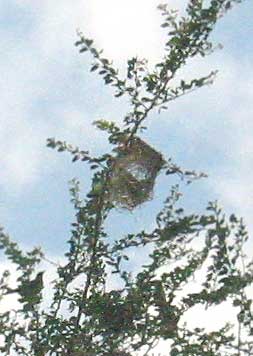Excerpts from Jim Conrad's
Naturalist Newsletter
from the April 14, 2008 Newsletter written in the community of 28 de Junio, in the Central Valley 8 kms west of Pujiltic, elev. ~700m (2300ft), ~N16.331°, ~W92.472°; southeastern Chiapas state, MÉXICO
STREAK-BACKED ORIOLES WEAVING NESTS
Streak-backed Orioles, ICTERUS PUSTULATUS, are mostly orange birds, the heads flushing a bit with redness, the tails black, the wings black with plenty of white streaking, and the backs orange with heavy black streaks running lengthwise. They're non-migratory and are distributed from just south of the Arizona border through western Mexico to Costa Rica.
The other day I noticed one repeatedly visiting a banana tree so I went to see what was going on. The bird was gathering fiber from banana leaves for her nest. She'd land on the midrib, bend over and yank and tug awhile, and before long she'd fly away with a curly, stringlike fiber in her beak.
 I've noticed several other orioles weaving their nests this week, too. Oriole nests are woven cups or pouches of woven plant fibers slung under a tree branch. The Streak-backed's nest isn't nearly as deep as an oropendola's or an Altamira Oriole's, but it's deeper than most other oriole species', maybe 1.3 times deeper than broad. Though I'm not sure it's a Streak-backed's, you can see a half-finished oriole nest, the top part fairly well advanced but the sky showing through the unfinished bottom, at the right.
I've noticed several other orioles weaving their nests this week, too. Oriole nests are woven cups or pouches of woven plant fibers slung under a tree branch. The Streak-backed's nest isn't nearly as deep as an oropendola's or an Altamira Oriole's, but it's deeper than most other oriole species', maybe 1.3 times deeper than broad. Though I'm not sure it's a Streak-backed's, you can see a half-finished oriole nest, the top part fairly well advanced but the sky showing through the unfinished bottom, at the right.
Speaking of orioles, North America's Orchard Orioles have been very common here all winter, but silent. During last Wednesday's breakfast, however, one for a few seconds burst into full song. And what memories that evoked of that very song issuing ever so sweetly yet a tad monotonously from deep inside tree shadows during deliciously long, summer afternoons up north.